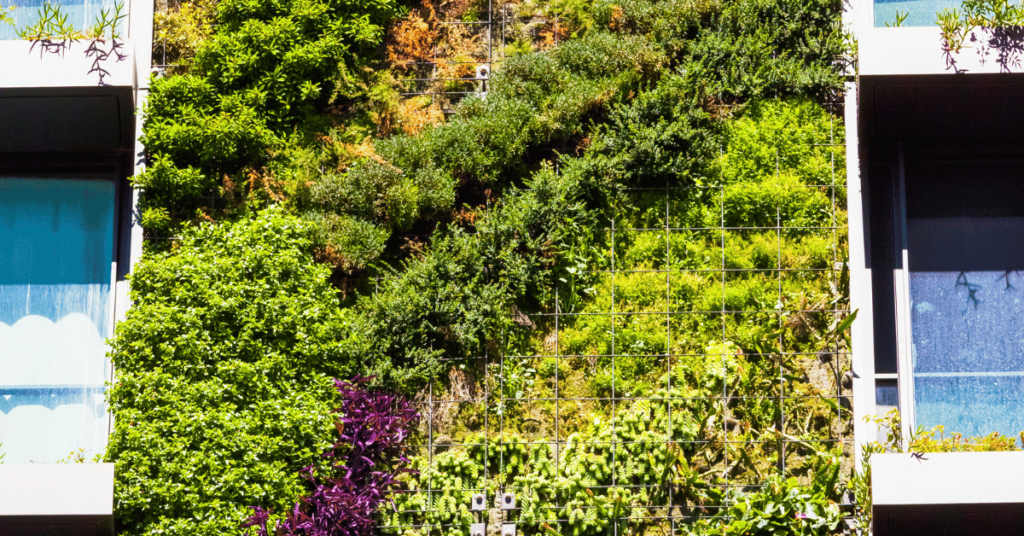Recently, we wrote how Brisbane’s skyline is about to change with construction heading up not out. This upward trajectory of high-rise housing density due to land scarcity and population growth made us ponder the growing trend of green wall systems on high rise buildings – and just how green are they?

What is a green wall?
A green wall covers a building’s facade with greenery for ecological purposes, where the vegetation becomes a part of the building’s design. Green walls are also commonly known as ‘vertical gardens’ or ‘living walls’.
Green wall high rise buildings – Is it just a marketing ploy?
Are green wall systems just a disguise in an attempt to dress up concrete jungles? Or is there sustainable design validity behind the hype that translates practically into an ecological reality?
Below we investigate some pros and cons of green wall systems on high-rise buildings.
Green wall high rise buildings – Pros
There are in fact, quite a number of environmental benefits to green wall systems. Some of these are:
- There’s less rainwater wastage to drains, and it aids flood mitigation by minimising water runoff due to absorption from the green wall vegetation
- Green wall systems provide organic shading
- Less heat is reflected, in turn, reducing urban temperatures
- It provides energy efficiency and savings due to its thermal insulation – reduction in energy consumption for cooling
- It emits oxygen, absorbs CO2 and captures particles of pollution which improves the quality of air
- Uniquely addresses some issues around land scarcity – for instance, it encourages the propagation of greenery when there’s a lack of space for parks
- It provides for a reduction of the greenhouse effect
- Reduces noise
- Increases biodiversity eg. frogs, bees, birds etc
- And there are even social benefits – aesthetics can have a positive impact on mental wellbeing and reduce stress levels
Green wall high rise buildings – Cons
So, all’s good in the green concrete jungle? Well, almost. As with all positives, there are some negatives. This is what we uncovered:
- There’s a significant cost involved with green walls for the initial outlay
- There’s also a substantial cost for the ongoing maintenance, such as horticultural staff maintenance costs (note though – the development of newer technologies may make maintenance an easier prospect with time)
- Concerning maintenance, it’s important to have a good supporting waterproof structure in place with irrigation, drainage and nutrition systems, and ensure automated systems don’t fail, which they have been known to do
- Then there are still the knowledge gaps about how to keep the greenery alive long term and how to develop designs suited to the Australian conditions. Benefits vary depending on climate / location, light, and the building’s geometry
- There’s currently a lack of guidelines for the green wall systems
- There can be council holdups for new application approvals
Australian green wall examples
One Central Park in Chippendale, Sydney, is an example of a successful green wall residential high rise with 35,000 plants – one of the largest green facades in Australia. The façade design was revised at inception to accommodate the green walls and meet sustainability objectives. The irrigation uses blackwater from the building itself.
Whilst not on the building façade, One Bligh Street in Sydney has a spectacular 40 metre long green wall that runs on recycled water. It has been well maintained and showcases the potential for green wall success.
However, when looking at Brisbane, we have a different climate – how would the sun affect replication in a different location? As mentioned earlier, there are still knowledge gaps and challenges in keeping the greenery alive in different climates and for the long term. But that’s not to say Brisbane isn’t jumping on board, and it appears to be occurring mainly with the build-to-rent asset class.

The Takeaway
Undoubtedly, as environmental concerns continue to dominate and become the norm, there will only be an increasing demand for green construction. Consumer appetite for eco-friendly cities will likely lead to increased government incentives encouraging more sustainable building practices that lessen our carbon footprint.
Once there are clear guidelines available for green walls on high rise builds, it would be good to see the government getting more involved to ensure that a certain quota of buildings is required to have green walls when meeting their development application approval criteria. At this stage, Brisbane City Council has a Buildings That Breath guide.
The exciting takeaway for construction will be the new job roles created in designing buildings due to the increasing demand for sustainable building practices, increased opportunities in green construction and newer technologies for improved project outcomes.
(Sources: Hanna Golasz-Szolomicka and Jerzy Szolomicki 2019 IOP Conf. Ser.: Mater. Sci. Eng. 603 022067; SMH 2013; RICS 2023; The Fifth Estate 2018; Architecture & Design 2014; UrbanNext 2023; Fytogreen 2016; Brisbane City Council 2023; The Urban Developer 2023)
Looking for your next construction job? Search our current construction roles here, or to chat with our team about securing your next opportunity, get in contact with us through our Contact Us page.
Receive our updates straight to your inbox




